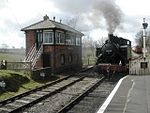Tithe Barn, Manor Farm, Doulting

The Tithe Barn at Manor Farm (also known as Abbey Barn) in Doulting, Somerset, England, was built in the 15th century, and has been designated as a Grade I listed building, and scheduled as an ancient monument.Tithe barns were used to store tithes, from the local farmers to the ecclesiastical landlords. In this case the landlord was Glastonbury Abbey. A tithe (from Old English teogoþa "tenth") is a one-tenth part of something, paid as a (usually) voluntary contribution or as a tax or levy, usually to support a Christian religious organization. The stone barn has eight bays supported by buttresses and two wagon porches. The cruck roof trusses, at both ends of the barn, have timbers which have been shown by dendrochronology to have been felled between 1288 and 1290. There are some curved windbraces.The stonework is showing signs water damage and erosion at the base of the walls.
Excerpt from the Wikipedia article Tithe Barn, Manor Farm, Doulting (License: CC BY-SA 3.0, Authors, Images).Tithe Barn, Manor Farm, Doulting
Farm Road, Mendip Doulting
Geographical coordinates (GPS) Address Nearby Places Show on map
Geographical coordinates (GPS)
| Latitude | Longitude |
|---|---|
| N 51.1854 ° | E -2.5056 ° |
Address
Farm Road
Farm Road
BA4 4QG Mendip, Doulting
England, United Kingdom
Open on Google Maps











